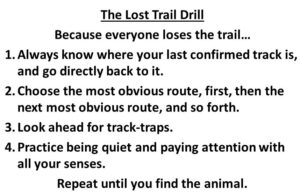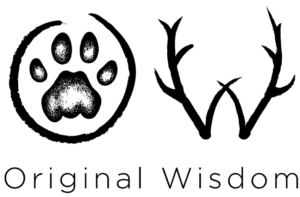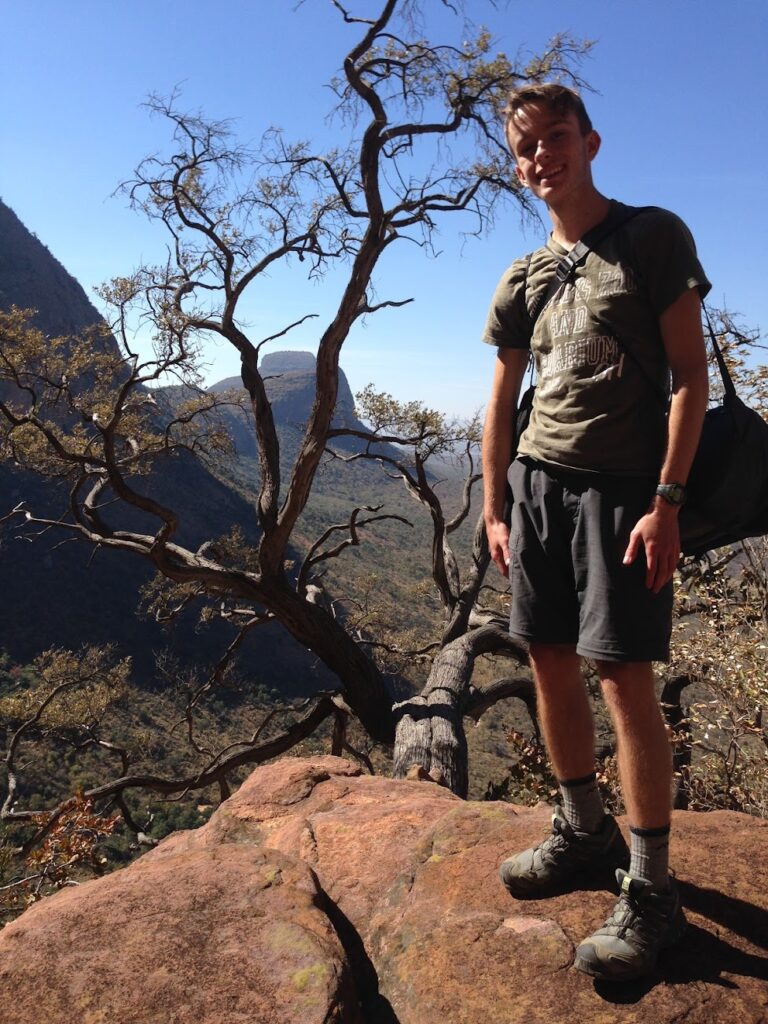When I was recently teaching and evaluating trackers in the USA, I gave out little, wallet-sized, laminated cards for them to keep in their pockets. The cards gave away the “Secrets of Success.” The secrets are explained an exercise called The Lost Trail Drill in our online course, An Introduction to Tracking, at Tracker Mentoring. Here is what the cards said:

There it is. There you have it. Those are the big secrets.
The Lost Trail Drill is A PROCESS for what to do to recover a lost trail.
Simple, right? It really is. It’s not always EASY, but the process is simple. Making yourself actually WORK the process can be the most difficult part. Let me go a little deeper…
So, the first thing to do while you’re trailing is to keep your head up. This enables you to see the trail a lot easier in most cases, gives you a sense of the animal’s direction, and allows you to see if you are about to spook the animal (or another one) out of its bed. While your head is up, you’re not looking down at every track, and maybe you don’t see where the animal took a slight (or abrupt) turn.
How do you find the trail again?
You could start randomly searching in ever widening circles. But then, you’d step on the tracks if you don’t see them because of poor lighting or because you are stepping across them and don’t recognize them from a side view or because another animal has stepped on them, or a leaf has blown into them, at that exact spot. There are dozens of reasons this isn’t a good idea.
What you need, is a PROCESS. The Lost Trail Drill is a SYSTEMATIC PROCESS that, over time and with practice, becomes automatic and instead of slowing you down, and actually makes your tracking more efficient.
First, go back to your last confirmed track. Some trackers can remember where their last track is, others need to occasionally mark a track with a line drawn from your shoe or a tracking stick. Then, when you need to go back, you just go back to the last-known, or last-marked track. You don’t need to mark every track, just every 5 meters or so, and do it quietly. The sound of marking a track can be very satisfying to the tracker’s ear and psyche, but the noise will give away your presence to the animal you are following.
From your last track, look for the most probable routes that the animal was likely to have taken. Take into account the overall trajectory that you have been going in, and the behaviour of the animal at the time. Was it hunting if it was a predator? Was it feeding if it was a herbivore? Was it patrolling? Then, go check the first, most obvious route. Only go 3-5 meters forward along that route, checking for the animal’s tracks. If you find its tracks, great, keep going! If not, GO ALL THE WAY BACK TO YOUR LAST TRACK, and then check the second most obvious route. Keep repeating this process until you find its tracks. It’s important to always GO ALL THE WAY BACK TO YOUR LAST TRACK and not start doing the random circling we first described. That might seem more efficient to you while you’re searching for tracks, but trust us, it’s not.
It’s important not to go too far down each obvious route. Look for track-traps up ahead. Track traps are sandy areas (or just good substrate) that, if you look there, and your animal’s tracks are not there, you will know immediately that it hasn’t gone that way and you can rule it out. Conversely, if the animal has walked that way, you will see them. Trust yourself to know when they are there, and when they aren’t. Your track recognition, the ability to recognize difficult tracks, will get better over time.
Whenever you get flustered, instead of zeroing in on the ground and focusing all of your energy at your feet, push-out your senses. Lift your eyes and scan the horizon, look into the bushes and shady spots. Listen to the noises, birds and other animal communications, and for the “quiet places” that might give away the presence of a predator (sometimes the absence of sound is just as revealing as its presence). Smell the good earth, or the presence of dung or a carcass. Feel the direction of the wind or the warmth of the sun on the back of your neck. Think about the animal you are following. Where would you be if you were the animal at this time of the day, and what would you be doing? These things will help to keep you safe and improve your tracking (and also your presence in the more-than-human world).
Work this process, over and over, until it becomes automatic. It might feel slow at first, but over time you will become more efficient at it, and then it will become quicker.
Practice The Lost Trail Drill. Actually, all you need to do is practice tracking, because you will lose the trail at some point, and THEN, use the Lost Trail Drill to help you recover it. Even Master Trackers lose the trail.
If you like this, please share it, and tag us at #trackingisoriginalwisdom, #trackermentoring, #natureguidetraining, and #cybertracker
<strong>Download Original Wisdom’s recommended reading list for trackers by signing up for our newsletter!</strong>
<strong>Once the sign-up form has been submitted, you will be re-directed to the download page.</strong>
Our recommended reading list is specific to Southern Africa and North America, but, a good tracking book is helpful in any region as a starting point to learn how to look at track morphology and animal behavior.
[contact-form-7 id=”2892″ title=”Subscribe to the newsletter”]
<h1><strong>Interested in online and correspondence tracking courses? Visit us at </strong><a href=”https://trackermentoring.com/”><strong>TrackerMentoring.com</strong></a><strong>!</strong></h1>

